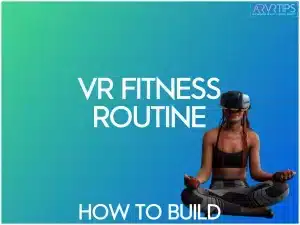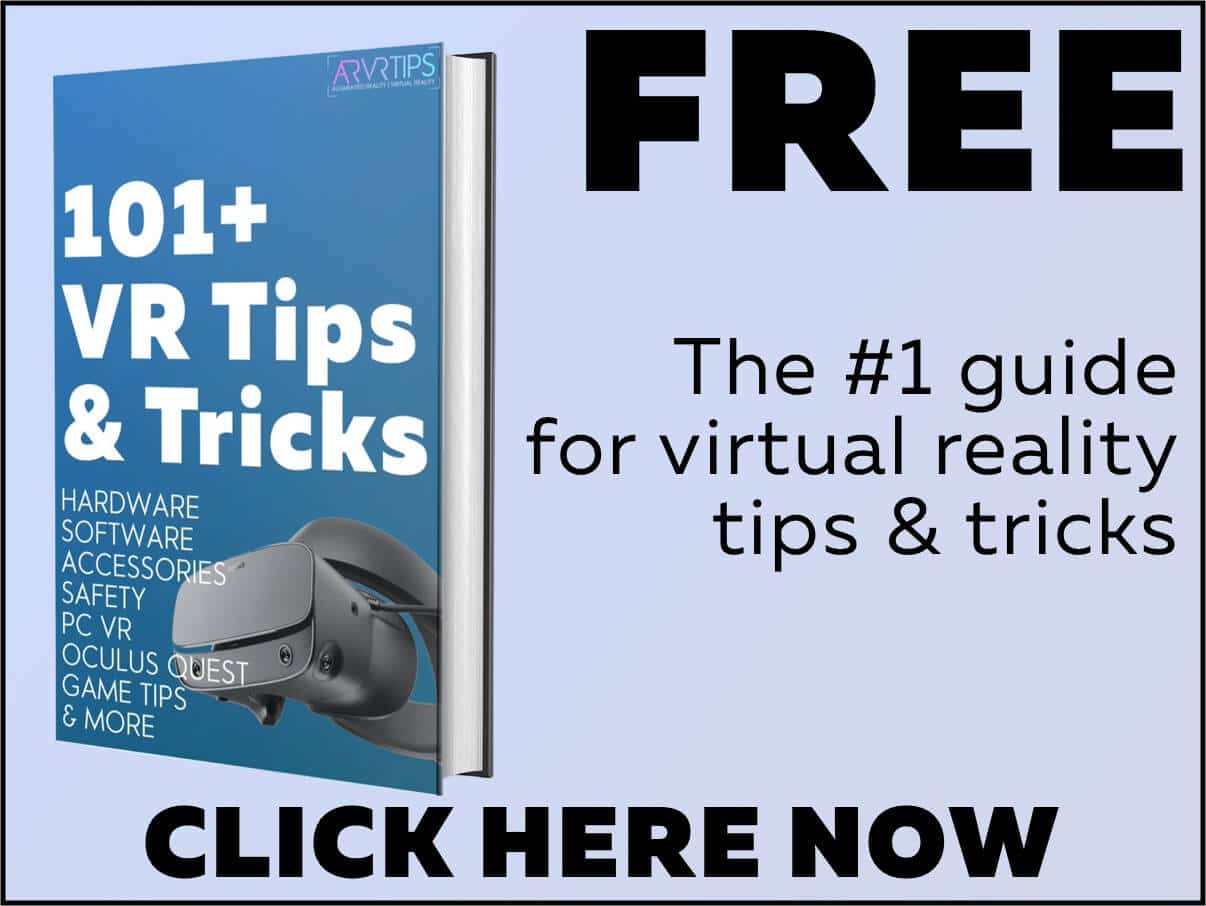Virtual reality has revolutionized the fitness world, offering immersive and engaging workouts right in your living room. This guide will help you build an effective VR fitness routine tailored to your goals and preferences.
I’ll cover everything from choosing the right equipment and games to tracking your progress and overcoming common challenges.
By the end of this article, you’ll have all the tools you need to create a sustainable and enjoyable VR fitness routine.
Related: Check out the best VR fitness games to play.
What is VR Fitness?

Virtual reality fitness is a new and exciting way to stay physically active using virtual environments and interactive gameplay. Blending physical movement with the immersive experience of VR provides a fun and engaging alternative to traditional workouts, appealing to people who might otherwise find exercise boring.
Many VR fitness apps offer a variety of workout options.
VR fitness offers a range of workout options tailored to different fitness goals, allowing you to engage in activities like:
- cardio
- strength training
- flexibility exercises
- martial arts
all within virtual reality!
Types of VR Workouts
Cardio-Focused Workouts
The most popular cardio-based VR workouts are rhythm or dance games. In these games, you must move your body in time with the beat or avoid obstacles. These games typically involve fast, repetitive motions, which help raise the heart rate and provide a solid aerobic workout.
Some of my favorite cardio games are:
- Beat Saber
- Synth Riderz
- OhShape
- Supernatural
These games are highly motivating because of their engaging gameplay, helping you forget that you are even exercising. You will burn calories by jumping, dodging, and swinging your arms to the time of the beat.
Strength and Resistance Training: Lifting Weights
There are also some virtual reality options for strength training. These games focus on resistance exercises to build muscle. While VR strength training is effective, incorporating traditional exercises like lifting weights can further enhance muscle building.
VR strength training games incorporate movements such as:
- squats
- lunges
- push-ups
- lifting virtual weights
Strength games provide a low-impact way to engage multiple muscle groups. VRWorkout is my favorite strength training VR game.
Yoga and Flexibility
VR Fitness offers yoga and meditation-based games if you are looking to improve your flexibility, balance, and mental well-being. These workouts guide users through various yoga poses, stretches, and breathing exercises in calming virtual environments.
Yoga VR is my favorite option in this space.
Boxing and Martial Arts
Boxing and martial arts-inspired VR workouts, such as a boxing game, provide high-intensity, full-body workouts. These games simulate sparring matches, training drills, or combat scenarios, encouraging you to punch, dodge, block, and kick.
Boxing VR workouts, like FitXR or Thrill of the Fight, are particularly effective if you want to try high-intensity interval training (HIIT) because the constant movement challenges endurance, strength, and cardiovascular health.
Benefits of VR Fitness
- Increased Motivation and Engagement: The immersive, game-like nature of VR fitness helps keep you motivated by turning exercise into a fun and interactive experience. In each game, you must focus on completing tasks or achieving high scores, making workouts less like a chore. Some VR fitness apps include a ‘personal trainer’ to guide and motivate users through their workouts.
- Full-Body Workouts: VR fitness typically engages multiple muscle groups as you move your whole body. This leads to a comprehensive workout that boosts cardiovascular health, strength, and endurance.
- Low-Impact Exercise Options: Many VR fitness games and apps offer low-impact exercises, making them ideal for people with joint issues or those seeking gentler exercise. Activities like yoga, tai chi, and certain rhythm-based games provide effective workouts.
- Convenience and Accessibility: I love that VR fitness routines can be done from home, requiring minimal equipment. It’s convenient if you have a busy schedule or may not have access to a gym.
Choosing the Right VR Equipment for Fitness

VR Headsets for Fitness
Popular headsets for VR fitness include devices like the Meta Quest and HTC Vive. These headsets are designed for immersive gaming and fitness experiences, offering accurate motion tracking and high-quality visuals to enhance workouts.
You must also choose between a stand-alone, battery-powered VR headset and a PC-connected option. Standalone headsets (like the Meta Quest) operate wirelessly without needing a PC, offering greater freedom of movement. PC-connected headsets (like the Valve Index or HTC Vive) require a computer and are often tethered by a cable.
For fitness, choosing a headset that fits comfortably and securely is essential, especially during vigorous activity. Adjustable straps, lightweight designs, and good weight distribution help maintain comfort over longer workout sessions.
Additional VR Fitness Accessories
Some VR fitness apps work with fitness-specific controllers designed for workouts, offering better grip and durability. These controllers are often more comfortable to hold during intense movements like punches or swings, ensuring better tracking and control during exercise.
Since VR fitness can be physically demanding, some headsets or accessories come with sweat-resistant padding or face covers that are easy to clean, improving hygiene and comfort during intense workouts.
For safety and comfort, non-slip mats or floor covers provide stability during fast-paced or high-intensity VR workouts. These mats help prevent slipping, especially when doing movements like jumping or pivoting, making the exercise environment safer.
Try out some of these accessories:
Amazon – Sweat Guard for Meta Quest 2/3
Amazon – Head Fan
Amazon – Mat for Floor
Building Your VR Fitness Routine

Building a VR fitness routine can be an exciting and effective way to stay active. Incorporating the most popular VR games like Beat Saber or Gorilla Tag can make your workouts more immersive and physically engaging.
When selecting games for your routine, consider popular VR games that offer engaging and effective workouts.
Assessing Your Current Fitness Level
Start by evaluating your current fitness level through simple tests, like:
- measuring endurance (how long you can jog in place)
- strength (push-ups)
- flexibility (reaching your toes)
Tracking daily activity levels, heart rate, and overall stamina will give you a clearer understanding of your fitness baseline.
Before beginning a VR fitness routine, especially if you have any health concerns, it’s important to consult with a doctor or fitness professional. They can help you identify physical limitations or recommend the safest way to start and progress your exercise plan.
Selecting VR Fitness Games and Apps
Cross-train by incorporating various VR games and VR apps to avoid workout monotony and target different muscle groups. Combine boxing for strength, rhythm games for cardio, and mindfulness apps for flexibility. This balanced approach keeps workouts engaging while ensuring a comprehensive fitness routine.
Below is a list of the top VR Fitness Apps:
- Supernatural
- FitXR
- Beat Saber
- VRWorkout
- Holofit
Check out our guide for more detailed information on the best VR Fitness Apps!
Creating a Balanced Full Body Workout Plan
Plan out your week by scheduling different VR workouts on specific days. For example, dedicate certain days to cardio-based games, dedicate others to strength training, and reserve some time for flexibility or mindfulness exercises.
Include a mix of workouts in your plan, including cardio, strength, and flexibility. You can also use different apps for the same type of workout to help make it interesting and new. This keeps your body challenged and balanced, promoting overall fitness improvements.
Tracking Your VR Fitness Progress
Built-In VR Fitness Tracking Tools
The Meta Quest has a built-in fitness tracker called Oculus Move, which tracks calories burned, active minutes, and heart rate during VR workouts. These tools help monitor your progress and set daily or weekly activity goals.
Wearable Fitness Trackers and VR
Many VR fitness platforms are compatible with popular wearable fitness trackers like Fitbit, Garmin, and Apple Watch. This compatibility allows users to monitor their heart rate, calories burned, and other fitness metrics seamlessly during VR workouts.
Wearable fitness trackers enable users to aggregate their VR workout data with non-VR fitness activities. By tracking all fitness metrics in one place, users can comprehensively view their overall activity levels, monitor progress over time, and adjust their fitness routines accordingly.
Integrating VR Fitness Into Your Overall Wellness Plan
Nutrition and VR Fitness
Proper nutrition before VR workouts is essential for optimal performance. Consuming a balanced meal or snack that includes carbohydrates, protein, and healthy fats 1-2 hours before exercising can provide the energy needed for high-intensity activities.
After a VR workout, it’s important to replenish your body with nutrients. Focus on consuming a meal or snack rich in protein and carbohydrates to aid muscle recovery and restore energy levels. Options like smoothies, protein shakes, or a balanced meal with lean protein and whole grains are ideal.
Staying hydrated is also crucial, especially during intense VR workouts, which can lead to significant sweating. Drink water before, during, and after your sessions to maintain hydration.
Recovery and Rest in VR Fitness
Rest days allow your muscles to recover, repair, and grow stronger. Incorporating regular rest days into your VR fitness routine helps prevent overtraining, reduces the risk of injury, and improves overall performance in subsequent workouts.
Quality sleep is also crucial to recovery and overall fitness performance. Adequate sleep helps repair muscles, supports mental focus, and enhances physical endurance.
Troubleshooting Common VR Fitness Challenges
Dealing with Motion Sickness
Many users experience motion sickness when first using VR, but there are ways to minimize this discomfort. Start with shorter sessions in VR to allow your body to adjust. Gradually increase the duration as you become more comfortable with the experience.
Many VR games also offer settings to help alleviate motion sickness, such as reducing movement speed, enabling teleportation instead of smooth locomotion, or adjusting the field of view. Experiment with these settings to find what works best for you.
Maintaining Hygiene in VR Workouts
- Cleaning Your VR Equipment: Regularly clean your VR headset and controllers to prevent dirt, sweat, and bacteria buildup. Use gentle cleaning wipes or microfiber cloths specifically designed for electronics.
- Managing Sweat During Workouts: To reduce sweat accumulation, consider using sweat-resistant accessories, such as face covers or sweatbands, to help absorb moisture. Keep a towel nearby to wipe your face and equipment during intense sessions.
- Replacing Worn-Out Accessories: Inspect your VR accessories regularly for signs of wear and tear. Replace items like facial interfaces, straps, or grips that are worn out or damaged. Doing so maintains hygiene and ensures optimal comfort during workouts.
Conclusion
By following my steps above, you can create a personalized workout plan that keeps you engaged and motivated. Remember to start slowly, listen to your body, and gradually increase the intensity of your VR workouts.
Track your progress, celebrate your achievements, and don’t be afraid to mix things up with new games and challenges. With consistency and dedication, your VR fitness routine can become an integral part of your overall wellness plan.


